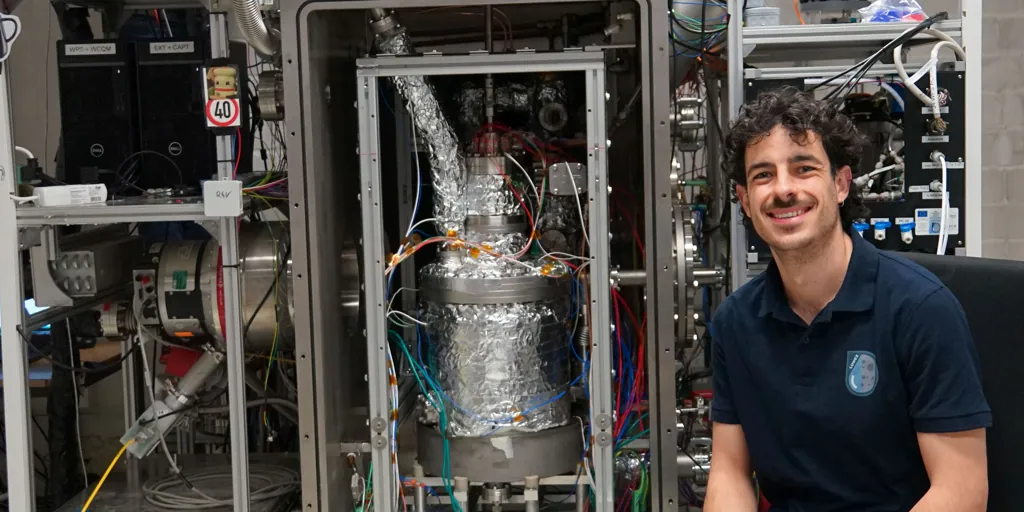Spanish physicist who wants to get drinking water from the moon

For a long time, the Moon was considered a completely arid world. Samples collected by the Apollo missions seemed to indicate that it consisted only of dust and rocks. However, the controlled impact of a NASA probe called LCROSS into a shadow crater at the moon’s south pole in 2009 completely changed what we thought we knew about it. Scientists found water vapor and ice in the cloud of material raised by the impact: 155 kilograms, according to data published a year later in the journal Science.
Later discoveries suggested that the water was even more widespread than previously thought, but “unequivocal” confirmation of its presence came in 2020. Then the US space agency observatory detected it directly and indicated the existence of large areas at the lunar poles. where he could be permanently stuck. This discovery is great news for space exploration, as future astronauts will be able to mine this resource for themselves.
Frozen at the poles
This is exactly what the young physicist Mateo Rejon (Granada, 1999), who has a Master’s degree in space engineering from the University of Delft (Germany) and a postgraduate scholarship from the La Caixa Foundation, is trying to do. Having worked for the European Space Agency (ESA) to learn how to use regolith (lunar sand) to make bricks and build homes on the Moon, he is now part of LUWEX, a pioneering project to extract water from lunar soil. whose trials have just begun at the Technical University of Braunschweig in Lower Saxony.
The experiment, funded by the European Union and led by the German Aerospace Center, aims not only to extract the liquid element from the frozen regolith, but also to purify it to provide rocket fuel and drinking water to the colonists of the future lunar station.
“There is a lot of water on the Moon, more than you would expect. And it froze at the poles. Since there is no atmosphere, when the Sun hits it, it evaporates and is lost in the vacuum of space. Therefore, it is necessary to go looking for it in areas that are never illuminated, in craters that are constantly in the shadows,” Rejon explains to this newspaper.
The experiment simulates the conditions existing on the Moon. The container contains regolith-like material partially frozen by water. This material is heated by steel rods that are rotated in a manner similar to “stirring ratatouille in a frying pan.” When heated, water sublimates. “This is the same process used to extract salt from seawater. The water evaporates and you are left with salt. But we are not interested in what remains, but in what evaporates, that is, water,” the researcher notes.
The water enters the cold trap, where it freezes again and is deposited again in the copper fingers. There, separated from the regolith, it is much cleaner. “Water should be filtered as much as possible to avoid the entry of tiny particles of regolith, the effect of which on health is unknown to us. The Moon also has trapped methane, which, whether inhaled or drunk, is very harmful. Eliminating it is a difficult task,” admits Rejon.
Four liters in a few hours
Scientists estimate that between 5 and 20 percent of every kilogram of regolith is water. “We want to extract as much water as possible, at least 75%. For every ten kilograms of the mixture there are four kilograms of water,” the physicist points out. This will be achieved in a matter of hours. The advantage is that you don’t have to take out much. On the Moon, the resulting water will be recycled and used again.
There are very few projects in the world like LUWEX, which has a budget of 1.5 million euros. If successful and there is interest from the space community, miniaturization of the technology will be developed so that it can be carried as a payload on board a spacecraft. Once on the moon, you’ll have to prove it works.
As Rejon comments, “Shipping water from Earth to the Moon to supply a colony entails enormous environmental and economic costs. Therefore, the goal is to exploit lunar resources. But not only to alleviate the needs of those who will settle there. Our natural satellite “is now understood as a store and gas station, a place where you can stop to refuel or get supplies before continuing your journey to other worlds, be it Mars or beyond,” he comments, “a waypoint for the mission are able to go further.
Like other space technologies, this one can also be useful here on Earth. According to the physicist, the device they use to purify water could be used in areas of severe drought or to improve drinking quality in places with limited resources.